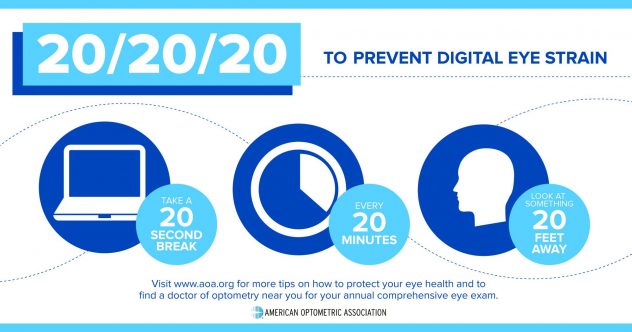Happy back-to-school!

Come get your eyes checked so you can see your “ABC”s. ??✏️ #alamoanaeye
20/20/20 To Prevent Digital Eye Strain
20/20/20 To prevent digital eye strain
- Take a 20 second break.
- Every 20 minutes.
- Look at something 20 feet away.

The average U.S. worker spends seven hours a day on the computer either in the office or working from home and the American Optometric Association’s (AOA) 2015 American Eye-Q® survey reports that 58 percent of adults have experienced digital eye strain or vision problems as a direct result.
Symptoms of digital eye strain, also known as computer vision syndrome, include eyestrain, headaches, blurred vision, dry eyes and neck and shoulder pain. The AOA recognizes the need to address this issue, and as Save Your Vision Month 2016 kicks off in March, they encourage both employees and employers to make eye health a priority. The five tips below can be easily implemented in most office spaces:
- Follow the 20-20-20 rule: Take a 20-second break, every 20 minutes and view something 20 feet away.
- Keep a distance: The AOA recommends sitting a comfortable distance from the computer monitor where you can easily read all text with your head and torso in an upright posture and your back supported by your chair. Generally, the preferred viewing distance is between 20 and 28 inches from the eye to the front surface of the screen.
- View from a different angle: Ideally, the computer screen should be 15 to 20 degrees, or about 4 to 5 inches, below eye level as measured from the center of the screen.
- Decrease glare: While there is no way to completely minimize glare from light sources, consider using a glare filter. These filters decrease the amount of light reflected from the screen.
- Blink often: Minimize your chances of developing dry eyes when using a computer by making an effort to blink frequently.
“As more people spend their days at work on a computer and their free time on handheld devices, doctors of optometry are seeing more patients who are experiencing digital eye strain,” said Steven A. Loomis, O.D., president of the AOA. “The problem can be relieved by taking simple steps. Just looking away from the computer for brief periods of time throughout the day can help with discomfort and long term eye problems.”
Top Eye-Healthy Foods? Hint: Not Carrots
Nutrient-rich foods can improve eye health, follow these recommendations from Dr. Dr. Tracie Inouchi
A balanced diet is an important foundation to maintain good health, but many Americans don’t know what nutrients are best for their eyes, and that diet can affect your eye health and vision as you age. Dr. Tracie Inouchi encourages Americans to visit their doctor of optometry annually to discuss proper nutrition and to ensure their eyes are functioning properly.
“It’s important for people to be proactive with their health—make good lifestyle choices now to help avoid problems later,” said Dr. Tracie Inouchi. “Stick to the building blocks for overall well-being: enjoy a nutrient-rich diet, stay active, and avoid harmful habits, such as smoking. All this can help people avoid sight-threatening disease and enjoy a lifetime of healthy vision.”

Drumroll—so what are the best foods for eye health? Forty-eight percent of Americans think of carrots as best, according to the American Optometric Association’s 2015 American Eye-Q® survey. Contrary to what many heard throughout childhood, kale, collard greens and spinach are actually the most nutrient-rich foods for the eyes. Dr. Tracie Inouchi recommends these eye-healthy “power foods.”
Power foods: Green, leafy vegetables (such as spinach and kale) and eggs
Eye-healthy nutrients: Lutein & Zeaxanthin
Good for the eyes because: Many studies have shown that lutein and zeaxanthin reduce the risk of chronic eye diseases, including cataracts and age-related macular degeneration (AMD), the leading cause of severe vision loss in adults over age 50. These plant-based pigments also appear to lower the risk of developing type 2 diabetes, a leading cause of blindness. They are also protective antioxidants that work like internal sunglasses, absorbing damaging blue light that Americans are exposed to every day.
Power foods: Fruits and vegetables
Eye-healthy nutrients: Vitamins A, C and polyphenols
Good for the eyes because: The eye’s light-sensitive retina (thin layer of tissue at the back of the eye) requires adequate vitamin A for proper function. Vitamin C supports the health of ocular blood vessels. Scientific evidence suggests vitamin C lowers the risk of developing cataracts, and when taken in combination with other essential nutrients, can slow the progression of AMD and visual acuity loss. Polyphenols are plant-derived substances that reduce inflammation, and are especially high in colorful fruits and vegetables.
Power foods: Nuts, fortified cereals and sweet potatoes
Eye-healthy nutrients: Vitamin E
Good for the eyes because: Vitamin E promotes the health of cell membranes and DNA repair and plays a significant role in the immune system. It has also been shown to slow the progression of AMD and visual acuity loss when combined with other essential nutrients.
Power foods: Salmon, tuna, and other cold-water fish
Eye-healthy nutrients: Omega-3 fatty acids
Good for the eyes because: Omega-3 fatty acids may reduce inflammation, enhance tear production and support the eye’s oily outer layer by increasing oil that flows from the meibomian glands. Research has also shown omega-3 fatty acids can play a role in preventing or easing the discomfort of dry eye.
The body doesn’t make the nutrients listed above on its own, so they must be replenished daily. In addition to a healthy diet, an eye doctor can recommend specific vitamins or other supplements for balanced nutrition based on each patient’s individual dietary intake, risk factors and laboratory analysis.
Visiting a doctor of optometry annually for a comprehensive eye exam is one of the best investments in overall health and is an important, preventive way to preserve vision and maintain healthy eyes. To make an appointment with Dr. Tracie Inouchi call (808) 949-2662.

